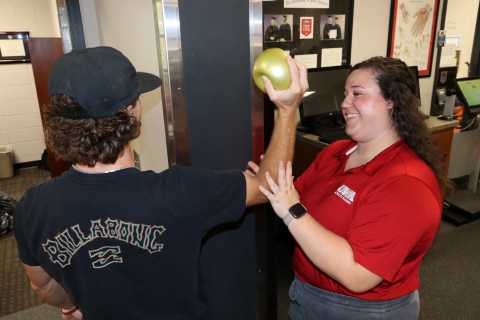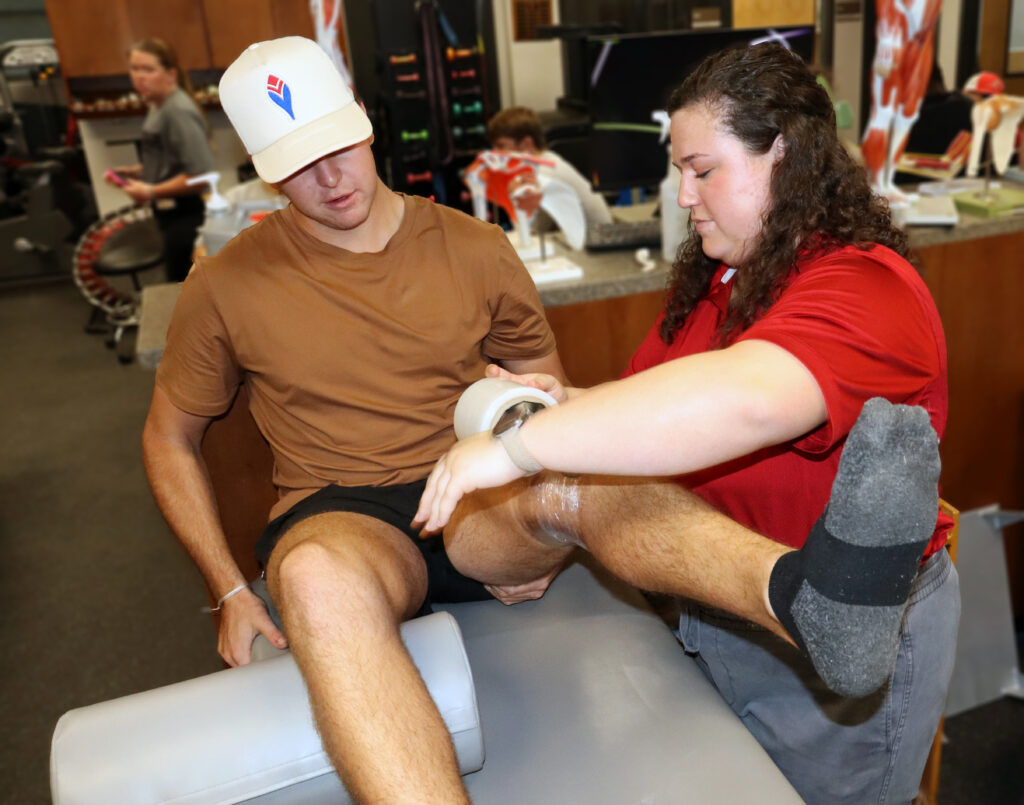
UWA’s Master of Athletic Training program provides 3+2 option that allows athletic trainers to earn the skills and credentials required to offer care in a broad range of fields
Story & Photos: Lisa Sollie
The University of West Alabama’s Athletic Training program has a new “first” to brag about. Not only was UWA the first public university in the state to receive approval for both a bachelor’s program in athletic training and a master’s program—but it can now boast a 100 percent first time pass rate for the first two Master of Athletic Training cohorts.
According to Dr. R.T. Floyd, director of athletic training and sports medicine at UWA and chair of the School of Health Sciences and Human Performance, the addition of the master’s degree in athletic training was necessary due to the changes in education requirements to become an athletic trainer.
“Once the fall term of 2022 began, accredited baccalaureate programs can no longer admit, enroll or matriculate students,” Floyd noted, “so someone desiring to become an athletic trainer after fall 2022 not already admitted to an accredited baccalaureate program will have to pursue the profession through an accredited master’s level program.”
Jordan Hall was in the university’s first cohort in the summer of 2020 and now serves as the athletic trainer/instructor assigned to UWA Baseball. After graduating with her Master of Athletic Training degree in May 2022, Hall did a yearlong internship at the University of South Alabama before she found herself back at UWA—teaching and practicing her athletic training skills among the same people that influenced her to be the athletic trainer she is today.
“UWA’s Master of Athletic Training program provided specialized knowledge, skills and more practical hands-on experiences than any university I have been involved with. It allowed me to apply theoretical knowledge in real-world settings dealing with actual athletes, both high school and college, as well as patients in the West Alabama community,” said Hall.
The program also helps students develop critical thinking skills, teaching them how to assess situations, make accurate diagnoses and develop effective treatment plans promptly.
“Athletic trainers often work closely with other healthcare professionals, coaches and athletes and the MAT program exposed me to an interdisciplinary approach, teaching me how to collaborate effectively with various stakeholders, such as physicians at Andrews Sports Medicine, outside providers, and other athletic trainers to ensure the overall well-being of the student athletes and patients. Earning my master’s degree in athletic training from UWA,” she added, “truly provided me with a well-rounded education and equipped me to excel in my role as an athletic trainer and instructor at the University of West Alabama.”
Employment of athletic trainers is projected to grow 14 percent from 2022 to 2032, much faster than the average for all occupations.
Bureau of Labor Statistics
The changing landscape of athletic training
While the root of the athletic training profession has most often been associated with sports, there is a growing trend of athletic trainers in clinics and hospitals, the industrial sector as well as the military.
“Many of the ATs that come to high school sporting events during the week work for a hospital or healthcare system. Some may work in a clinic part of the day and go out to the high schools the other part. Others may work exclusively in a clinic, doing hands-on patient care, evaluation and treatment, even administrative tasks or a mixture of both. Athletic trainers in the physician practice setting, especially in a sports medicine practice that houses orthopedics, is also a growing trend,” said Floyd.

Athletic trainers who work in industrial settings have also seen tremendous growth in their demand, particularly over the last five years.
“Anywhere there is a large population working in a factory or manufacturing setting there is a musculoskeletal opportunity for risk or injury,” he noted. “By putting an AT in a facility to study the work environment, they may notice someone ‘lifting something wrong’ or doing a repetitive task too many times. By modifying how workers are doing a task — an athletic trainer can perhaps minimize the problem and avoid potential injuries. It’s a win-win for everyone; it saves a company money, time and productivity and it is better for the employees’ overall health and welfare.”
According to Floyd, several UWA alumni currently work as industrial athletic trainers in the automotive industry including the Montgomery Hyundai plant, Nissan facility in Canton, Mississippi, as well Tupelo — and one has been working the past two years at WestRock paper mill in Demopolis.
“The military has also jumped on board and currently all the armed forces now utilize athletic trainers,” he added. “This past December I received three phone calls over a matter of days from a company that said they needed 600 ATs to work with the U.S. Army. Every single day I get more emails about open AT positions across all disciplines. The jobs are out there. We could place 150 today within the twin state area of Alabama and Mississippi for sure.”
UWA’s Master of Athletic Training program
UWA offers two options for pursing the master of athletic training. These options are designed to accommodate students who have already begun or completed their undergraduate studies, as well as those who are just beginning and want to pursue both graduate and undergraduate studies in athletic training.
Students, like Hall, who have already earned a bachelor’s degree (not in athletic training) and wish to enter the profession and earn the credential of a certified athletic trainer can earn the degree in a two-year master’s program.
UWA’s 3+2 MAT allows students to complete a bachelor’s degree in health science in the athletic training track in combination with the master of athletic training, in only five years (three pre-professional and two professional). The program leads to two separate degrees. The 3+2 MAT at UWA is designed for the traditional residential college student interested in an undergraduate experience combined with professional education in athletic training.
“Both degrees are granted upon final completion of the program,” Floyd explained. “Students complete all general education and health science major requirements by the end of the third year, then the additional credits for the master’s degree are earned through graduate level courses. The second phase is a year-round, 23-month curriculum that focuses entirely on athletic training professional content and hands-on patient care experiences.”
UWA’s 3+2 MAT requires continuous enrollment and is uniquely designed to teach students how to function in an inter-professional healthcare team that mimics real, dynamic health systems in which they will work.
Still in its infancy, UWA’s Master of Athletic Training program can support up to 20 students per cohort.